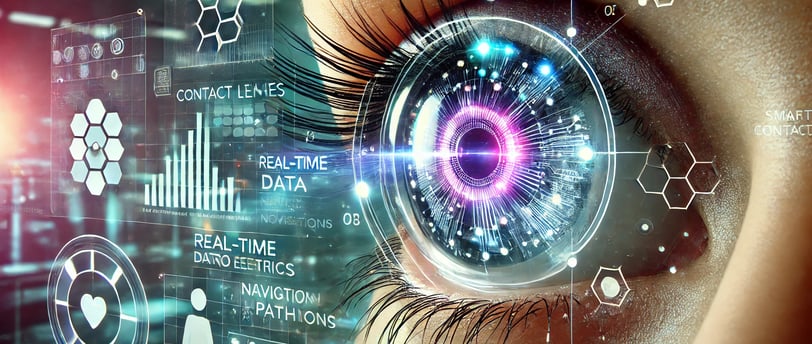Smart Contact Lenses: The Future of Vision and Technology Integration
Step into the future with Smart Contact Lenses! Explore how these revolutionary devices are transforming vision, healthcare, and augmented reality. Learn about groundbreaking companies like Mojo Vision and Google, and see how smart lenses are set to redefine technology. The future of innovation is here—are you ready to see it?


Introduction
Imagine a world where your contact lenses do more than just correct vision—they display augmented reality overlays, monitor your health, and even replace your smartphone. Smart contact lenses are set to redefine how we see and interact with the world. From real-time translations and health monitoring to immersive augmented reality (AR) experiences, these revolutionary devices are at the forefront of cutting-edge technology.
In this blog, we’ll explore the technology behind smart contact lenses, their game-changing applications, examples of companies leading this innovation, and what the future holds for this extraordinary technology.
1. What Are Smart Contact Lenses?
Smart contact lenses are tiny, high-tech devices embedded with microelectronics, sensors, and wireless connectivity, worn directly on the eye. Unlike regular lenses, they can:
Display information directly in your line of sight.
Monitor health metrics like glucose levels or intraocular pressure.
Enhance vision through augmented reality overlays.
How They Work:
Miniaturized Electronics:
Micro-LED displays provide visual information, while embedded sensors gather data.
Power Supply:
Powered by micro-batteries, solar charging, or wireless energy transfer.
Connectivity:
Bluetooth or Wi-Fi connects lenses to smartphones or cloud servers for real-time data exchange.
2. Groundbreaking Applications of Smart Contact Lenses
2.1 Augmented Reality (AR)
How It Works:
Smart lenses project AR overlays, such as navigation, notifications, or translations, directly onto your field of view.
Example:
A tourist in a foreign country sees real-time translations of street signs without looking at their phone.
Impact:
Eliminates the need for bulky AR glasses, merging technology seamlessly with everyday life.
2.2 Health Monitoring
How It Works:
Sensors track biomarkers like glucose levels (for diabetics) or intraocular pressure (for glaucoma patients).
Example:
A diabetic user receives alerts when their blood sugar rises, enabling immediate action.
Impact:
Revolutionizes chronic disease management, reducing reliance on invasive tests.
2.3 Enhanced Vision
How It Works:
Lenses adjust focus automatically or enhance low-light vision using AI.
Example:
A driver sees clearer images at night or during foggy conditions, improving safety.
Impact:
Helps individuals with visual impairments or those in high-stakes professions like pilots.
2.4 Immersive Entertainment
How It Works:
AR gaming and VR experiences are brought to life through smart lenses.
Example:
Gamers see virtual battlefields directly on their lenses, immersing themselves fully in the game.
Impact:
Redefines interactive entertainment, merging the real and virtual worlds.
2.5 Military and Tactical Use
How It Works:
Provides soldiers with vital information like enemy positions or mission objectives.
Example:
Real-time AR overlays help troops navigate unknown terrains or detect threats.
Impact:
Enhances situational awareness, boosting efficiency and safety in critical scenarios.
3. Companies Leading the Revolution
3.1 Mojo Vision
Focus:
Developing AR-enabled contact lenses with high-resolution micro-LED displays.
Innovations:
Smart overlays for athletes, providing real-time performance metrics.
Status:
Prototype in testing phases, targeting both medical and AR markets.
3.2 Google (Alphabet’s Verily)
Focus:
Creating lenses for glucose monitoring and healthcare applications.
Innovations:
Smart lenses with embedded sensors for diabetics to measure glucose levels in tears.
Status:
Medical partnerships underway for further development.
3.3 Innovega
Focus:
Combining contact lenses with AR/VR experiences.
Innovations:
Dual-focus lenses that work with smart glasses for high-quality AR visuals.
Status:
Positioned as a pioneer in immersive entertainment.
3.4 Samsung
Focus:
Integrating advanced camera and display technology into smart lenses.
Innovations:
Patents for lenses capable of projecting video content directly into the eye.
Status:
Development ongoing with potential to disrupt the AR market.
4. Benefits and Challenges
4.1 Benefits
Seamless Integration:
Eliminates the need for smartphones or glasses, making technology virtually invisible.
Enhanced Safety:
Hands-free AR navigation ensures safer driving or cycling.
Improved Healthcare:
Provides non-invasive health monitoring, improving early detection and management of diseases.
Convenience:
Compact and lightweight, ideal for users on the go.
4.2 Challenges
Miniaturization:
Developing ultra-small components that function reliably is a major hurdle.
Battery Life:
Powering the lenses efficiently without frequent charging remains challenging.
Privacy Concerns:
AR overlays and health data raise issues around user privacy and data security.
Cost:
Initial models are likely to be expensive, limiting accessibility for the general public.
5. The Future of Smart Contact Lenses
The potential of smart contact lenses is vast:
Personalized Augmented Reality:
Tailored AR experiences for education, gaming, and work productivity.
Advanced Medical Applications:
Integration with AI to detect early signs of diseases like macular degeneration.
Global Adoption:
As technology matures and costs drop, smart lenses could become as ubiquitous as smartphones.
Imagine This:
By 2030, smart contact lenses could:
Replace smartphones as primary communication devices.
Enable visually impaired individuals to see clearly for the first time.
Provide real-time AR interfaces in professional fields like surgery or engineering.
Conclusion
Smart contact lenses are no longer just a concept from science fiction—they are a glimpse into a future where technology and biology merge seamlessly. With the potential to revolutionize healthcare, enhance entertainment, and redefine how we interact with the world, these lenses are poised to become one of the most transformative innovations of the 21st century.
